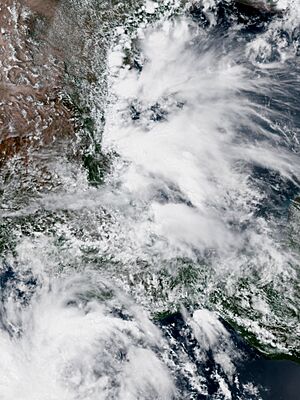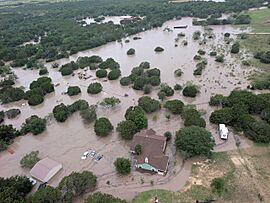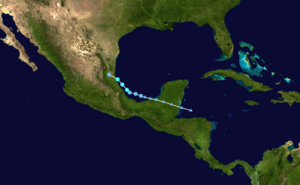Tropical Storm Barry (2025) facts for kids

Barry at peak intensity in the Bay of Campeche on June 29
|
|
| Meteorological history | |
|---|---|
| Formed | June 28, 2025 |
| Dissipated | June 30, 2025 |
| Tropical storm | |
| 1-minute sustained (SSHWS/NWS) | |
| Highest winds | 45 mph (75 km/h) |
| Lowest pressure | 1006 mbar (hPa); 29.71 inHg |
| Overall effects | |
| Fatalities | 8 direct |
| Damage | >$5.97 million (2025 USD) |
| Areas affected | Belize, Yucatan Peninsula, Eastern Mexico, Southern United States |
|
Part of the 2025 Atlantic hurricane season |
|
Tropical Storm Barry was a powerful but short-lived storm that brought heavy rain and flooding to parts of Mexico. It was the second named storm of the 2025 Atlantic hurricane season. Barry started as a tropical wave over the Bay of Campeche on June 28, 2025. Even before it became a storm, the weather system that would become Barry caused flooding in the Yucatan Peninsula and Belize.
After forming, Barry grew a little stronger and moved towards the Mexican state of Veracruz. It then made landfall near Tampico, Tamaulipas. Because it moved over mountains, the storm quickly weakened and disappeared. Sadly, eight people lost their lives in Mexico because of Barry. The storm also caused over US$5.97 million in damage, which is the cost to fix things.
Later, the leftover moisture from Barry combined with other moisture over Texas in the United States. This mix of moisture led to very heavy rains and serious flooding in Central Texas in early July. This flooding was very severe, and many people lost their lives or were still not found as of July 12, 2025.
Contents
How Tropical Storm Barry Formed
On June 27, a large area of stormy weather began to form over the Yucatán Peninsula. The next morning, this stormy area moved over the Bay of Campeche. It started to get more organized, with clear signs of a storm forming. The ocean water was warm, about 29 °C (84 °F), which helped the storm grow. Because of this, it officially became Tropical Depression Two that afternoon.
On the morning of June 29, it grew stronger and became Tropical Storm Barry. It was about 90 mi (140 km) east-southeast of Tuxpan, Veracruz. Barry moved northwest. It was guided by a high-pressure system that stayed in place over the central Gulf of Mexico. Strong winds high up in the atmosphere, about 25–30-mile-per-hour (40–48 km/h), kept Barry from getting much stronger.
That evening, Barry reached land south of Tampico, Tamaulipas. It quickly weakened back into a tropical depression. As it moved over the mountains of northeastern Mexico, the storm completely disappeared.
How People Prepared and What Happened
| Country | State/district | Fatalities | Damage (in USD) |
|---|---|---|---|
| Belize |
|
0 | Unknown |
| Mexico |
|
0 | $1.88 million |
|
|
2 | $268,000 | |
|
|
1 | $3.49 million | |
|
|
5 | $333,000 | |
| Total | 8 | >$5.97 million | |
Experts estimated that the cost of repairs would be more than US$1 million.
Effects in Mexico
Early Impacts: Yucatan and Belize
On June 28, before Barry even became a storm, parts of the Yucatan Peninsula had strong storms and winds of 15 to 30 kilometres per hour (9.3 to 19 mph). Some areas received a lot of rain, up to 428 mm (16.9 in). In Chetumal, 40 roads were damaged. Over 10,000 hectares of sugarcane crops were ruined. The city's water drainage system couldn't handle all the rain. More than 240 families had their homes damaged so badly they couldn't live in them. The total cost to fix things from this flooding was about Mex$35 million (US$1.88 million).
In Belize, the weather system before Barry caused serious damage to buildings and roads in rural areas, with many buildings collapsing. No one lost their life in Belize. Many landslides happened, and floods affected over 20 communities. Some areas received over 20 inches (508 mm) of rain. This caused water levels to rise at least 50 cm (19.7 in), which was the highest in 18 years. Families had to leave their flooded homes, and roads were damaged by mudslides. Orange Walk, Corozal, and Cayo District were the most affected areas.
Preparations for Barry
When Barry became a tropical storm, weather experts issued warnings for coastal areas. They also warned about possible floods in Veracruz. More than 100 shelters were opened in Tamaulipas to keep over 50,000 people safe from floods. Because Barry was coming, the Ministry of Education in Tamaulipas ended the school year early and stopped classes. Different levels of alerts were put in place for Veracruz. The state also stopped classes in 51 towns on June 30.
Veracruz and Tamaulipas Impacts
In Veracruz, some schools were damaged, and homes lost electricity. In Los Tuxtlas, over 370 mm (14.6 in) of rain fell. Twelve towns were affected, and seven homes were damaged. Overall, the cost of repairs in Veracruz was not too high, about Mex$5 million (US$268,000). In the city of Veracruz, two people lost their lives when strong waves, caused by Barry, swept their car into the sea.
In Tamaulipas, heavy rain and strong winds caused floods and damage. Some parts of the state received 200 mm (7.87 in) of rain. Three neighborhoods in Tampico were flooded. The Tamesí River overflowed its banks, affecting 5,000 families. Two trees fell in the city, damaging power lines and a fence. In Ciudad Victoria, rain from Barry caused streets to flood in lower areas. A bridge for people to walk on collapsed in Tamiahua because of the storm. Farmers lost at least 300 tons of salt, which affected over 40 of them. Thirteen schools were flooded. Many roads had to be closed, which caused problems for transportation. Over 330 homes were flooded, and many state and national roads were damaged. The cost to fix roads was about Mex$65 million (US$3.49 million). This included Mex$40 million (US$2.15 million) for state roads and Mex$25 million (US$1.34 million) for national roads. Sadly, a man lost his life when his car was swept away by an overflowing water channel.
San Luis Potosí Impacts
In San Luis Potosí, the leftover rain from Barry caused a stream to overflow, flooding streets. In Santa María del Río, trees fell down. At least seven towns reported damage. Water levels rose very high, up to 1.6 meters (5.25 feet). Over 400 homes and 15 cars were damaged in the Loma Bonita area of Tamazunchale. More than 100 homes were severely damaged. In Axtla de Terrazas, over 1,500 homes were flooded. The leftover rain also caused floods in the Huasteca region, where strong currents pulled cars into the water. Sadly, at least five people lost their lives in the state. Three people were swept away by an overflowing river while riding a special vehicle, and a young person died after being swept away by an overflowing river while in a car. In Puebla, rising water made people leave their homes for safety. Flooded streets caused cars to stop, and people needed help to get out of the water. The government set aside Mex$6.2 million (US$333,000) to help with recovery after the storm.
Effects in Other Areas
Even though it was far away, North Padre Island, Texas, felt some effects from Barry. Strong winds blew over beach tents, and the ocean waves were rough. Days later, the leftover moisture from Barry moved into Texas. This caused several days of thunderstorms. On average, Brownsville received 4.75 inches (121 mm) of rain. Harlingen had 3.55 inches (90 mm), and McAllen received 1.69 inches (43 mm).
Flooding in Central Texas

The leftover parts of Barry's storm system combined with other moisture from the Pacific Ocean. This combination caused very heavy thunderstorms and dangerous flooding in Central Texas on July 4 and 5, 2025. Some areas received an incredible amount of rain, up to 20.33 inches (516.4 mm). Sudden floods along the Guadalupe River led to at least 129 people losing their lives. A large number, 103, were in Kerr County. As of July 12, 2025, at least 166 people were still not found.
See also
- July 2025 Central Texas floods
- Tropical cyclones in 2025
- Timeline of the 2025 Atlantic hurricane season
- Other storms with the same name
- Tropical Storm Bret (2005) – took a similar track around the same time of year
- Tropical Storm Barry (2013) – storm with the same name that took a similar track
- Tropical Storm Fernand (2013) – took a similar track
- Tropical Storm Dolly (2014) – took a similar track
- Tropical Storm Danielle (2016) – took a similar track
- Tropical Storm Alberto (2024) – took a similar track a year earlier
- Tropical Storm Chris (2024) – took a similar track around the same time of year


